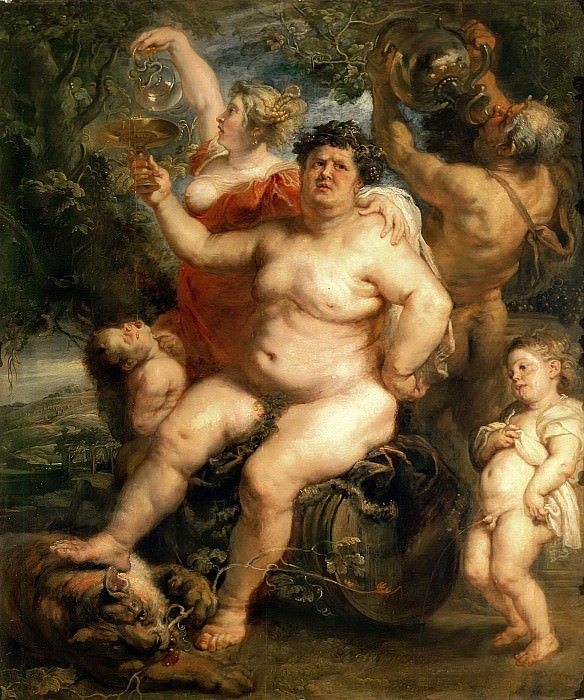Bacchus Peter Paul Rubens (1577-1640)
Peter Paul Rubens – Bacchus
Edit attribution
Download full size: 1556×1868 px (0,7 Mb)
Painter: Peter Paul Rubens
Rubens is a Flemish painter, a master of the Baroque - his paintings represent almost the essence of that style. He is cheerful, vivid, with much detail; they honor life and glorify it, representing almost a slap in the face of death. He preferred religious and mythological subjects, especially revealing the myths of ancient Greece. Bacchus - aka Dionysus, aka Bacchus - the god of winemaking, inspiration, vegetation, and the life force that nourishes everything.
Description of Peter Rubens’ painting Bacchus
Rubens is a Flemish painter, a master of the Baroque - his paintings represent almost the essence of that style. He is cheerful, vivid, with much detail; they honor life and glorify it, representing almost a slap in the face of death. He preferred religious and mythological subjects, especially revealing the myths of ancient Greece.
Bacchus - aka Dionysus, aka Bacchus - the god of winemaking, inspiration, vegetation, and the life force that nourishes everything. Where he passes, unbridled pretty girls go with him, wine pours, universal feasts and festivities reign, where there is room for everyone who wants to have fun.
Rubens depicts him as a fat man, sitting on a barrel of wine and raising a bowl into which the same wine is poured. His Bacchus is obese and, judging by his face - flabby, almost brooding - close to getting tired of the perpetual turmoil going on around him. He wears a wreath of clusters of grapes on his head.
Around him, people are drinking - a man, also naked, pours wine directly from a jug into his mouth, a woman has bared one breast and is serving her lord, children around - one drinks wine pouring from the cup of Bacchus, the other is urinating, apparently, getting rid of the drunken wine. The big cat beneath the god’s foot lies on its side, looking content and obediently letting itself be rolled.
The whole composition pulls toward Bacchus as the center. He, who allows us to get rid of all moral and other inhibitions, to open up to the world and become for a time drunk, mad and happy, gives meaning to our own bacchanalia. Without it, it would be an ugly feast of madmen. With him, there is a kind of higher meaning in it, a liberation and a boundless joy of savagery.
Some people will be disgusted by the painting, others will be tempted to join Bacchus’ retinue, in which one can look anything: fat, drunk. Insane.
Кому понравилось
Пожалуйста, подождите
На эту операцию может потребоваться несколько секунд.
Информация появится в новом окне,
если открытие новых окон не запрещено в настройках вашего браузера.
You need to login
Для работы с коллекциями – пожалуйста, войдите в аккаунт (open in new window).




















COMMENTS: 5 Ответы
Вечное искусство – принадлежит всем
сцущего ребенка можно было не рисовать )))
Думаю, могу дополнить информацию про таких существ как дриады: http://volshebnaya-planeta.ru/?p=302
Думаю, что это картина отображает многих людей на Земле...
Эта картина, кроме всего прочего, семейный портрет. Мужчины (Вакх и Сатир), их общая жена (вакханка) и дети (слева пьёт вино ребёнок от Сатира, справа писает мальчик от Вакха).
You cannot comment Why?
To his left, a woman in a vibrant orange gown holds up a chalice, from which a stream of liquid descends towards a cherubic child. This child is depicted drinking from the stream, seemingly in a state of ecstasy or intoxication. Another woman stands behind Bacchus, her arm around his shoulder, and she too appears to be participating in the celebration.
On the right side of the composition, an older, muscular man with a full beard drinks directly from a large chalice, his head tilted back. Beside him, a small child stands with a look of innocence, perhaps representing purity in contrast to the surrounding indulgence, or simply a youthful observer.
At Bacchuss feet and to the left, a lion lies on the ground, its paw resting on a bunch of grapes. The lion is often associated with Bacchus and represents his power and dominion. The overall atmosphere is one of abundance, sensuality, and uninhibited festivity.
The subtexts of the painting revolve around the themes of wine, intoxication, pleasure, and the cyclical nature of life and fertility. Bacchus, as the god of wine, embodies the intoxicating effects of alcohol, which can lead to both ecstasy and oblivion. The ample depiction of the figures suggests a celebration of earthly pleasures and abundance. The presence of children, one actively partaking and the other observing, can be interpreted in various ways, perhaps highlighting the duality of innocence and experience, or the continuation of lifes joys through generations. The lion, a symbol of strength and wildness, is tamed by the presence of grapes, hinting at the power of nature and the pleasures it offers. The painting ultimately celebrates the delights of wine and revelry, but perhaps also a subtle acknowledgment of the excesses that can accompany such indulgence.